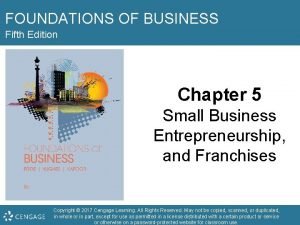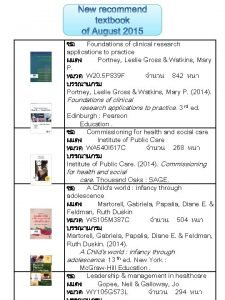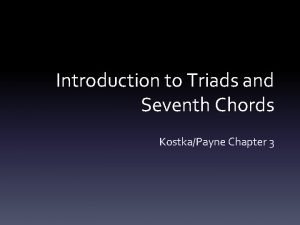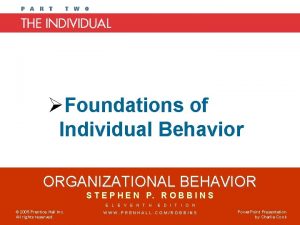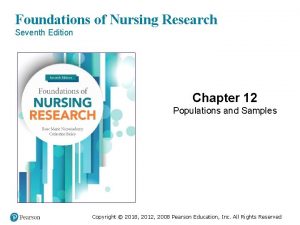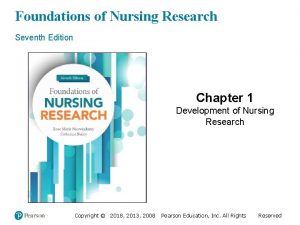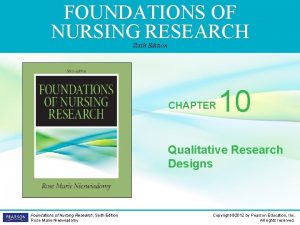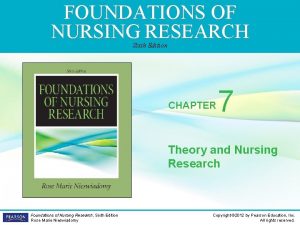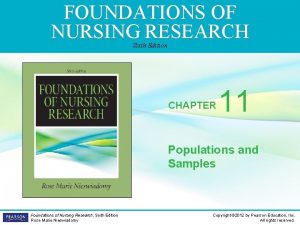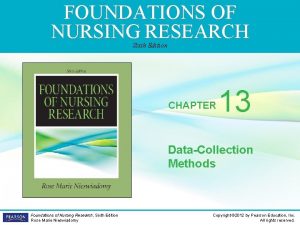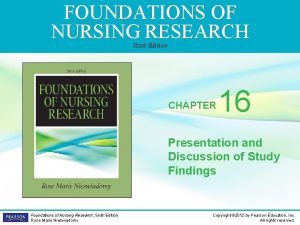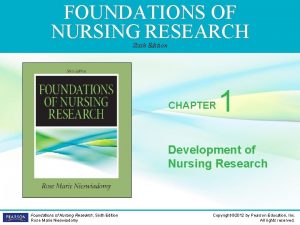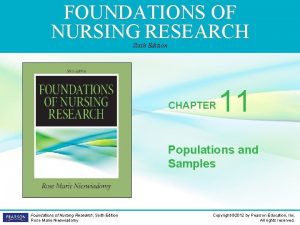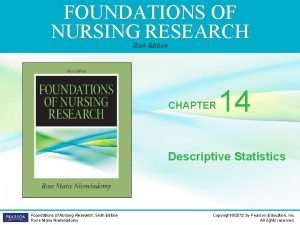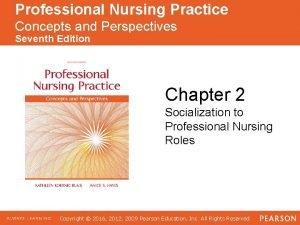Foundations of Nursing Research Seventh Edition Chapter 11


































- Slides: 34

Foundations of Nursing Research Seventh Edition Chapter 11 Qualitative and Mixed Methods Research Designs Copyright © 2018, 2012, 2008 Pearson Education, Inc. All Rights Reserved

Learning Objectives 11. 1 Summarize the important features of six common types of qualitative designs 11. 2 Discuss the main principles and purposes that guide researchers to use more than one method 11. 3 Describe the strategies a researcher might use in a mixed method study Copyright © 2018, 2012, 2008 Pearson Education, Inc. All Rights Reserved

Introduction (1 of 2) • Qualitative and mixed methods research are increasingly accepted. • Qualitative studies: – Are particularly well suited for questions about which there is little or no research. – Can often help answer questions about processes humans use to avoid, cope with, or adjust to illness and disease. Copyright © 2018, 2012, 2008 Pearson Education, Inc. All Rights Reserved

Introduction (2 of 2) • With quantitative research, qualitative results can be powerful and impactful. • Expert qualitative researchers often spend years becoming adept in using their preferred qualitative method. Copyright © 2018, 2012, 2008 Pearson Education, Inc. All Rights Reserved

Learning Objective 11. 1 Summarize the important features of six common types of qualitative designs Copyright © 2018, 2012, 2008 Pearson Education, Inc. All Rights Reserved

Qualitative Research Designs (1 of 18) • Six most common qualitative approaches – Phenomenology – Ethnography – Grounded theory – Narrative inquiry – Case study – Action research Copyright © 2018, 2012, 2008 Pearson Education, Inc. All Rights Reserved

Qualitative Research Designs (2 of 18) • Phenomenology – Examines human experiences § Descriptions areprovided by people involved § Lived experiences – Information is generally obtained through interviews. – Researcher must: § Have an accurate and clear notion of the phenomenon of interest. § Use descriptive questions to elicit the most complete responses. Copyright © 2018, 2012, 2008 Pearson Education, Inc. All Rights Reserved

Qualitative Research Designs (3 of 18) • Phenomenology – Bracketing § Take into account researcher’s own beliefs and feelings § Put aside expectations – Reflexivity § Researcher should attempt to clearly identify their values and beliefs as they relate to the topic and how they may influence the research – Research methods are very different from methods used in quantitative research. Copyright © 2018, 2012, 2008 Pearson Education, Inc. All Rights Reserved

Qualitative Research Designs (4 of 18) • Ethnography – Collection and analysis of data about cultural groups – Focuses on social relationships and context in which they occur – Several types § Classical § Natural § Interpretive § Critical Copyright © 2018, 2012, 2008 Pearson Education, Inc. All Rights Reserved

Qualitative Research Designs (5 of 18) § Digital § Autoethnography § Subjective evidence-based • Ethnography – Researcher frequently spends extended periods of time with group § Becomes a part of their culture § Explores rituals and customs § Interviews, images, observations, or interactions Copyright © 2018, 2012, 2008 Pearson Education, Inc. All Rights Reserved

Qualitative Research Designs (6 of 18) • Ethnography – Relatively new to nurse researchers – Used in anthropological research for a long time – Ethnographers study how people live and how they communicate with each other. Copyright © 2018, 2012, 2008 Pearson Education, Inc. All Rights Reserved

Qualitative Research Designs (7 of 18) • Grounded Theory – Glaser and Strauss (1967) – Good choice when area is one in which little research has been done, or in which existing theories are not sufficient. Copyright © 2018, 2012, 2008 Pearson Education, Inc. All Rights Reserved

Qualitative Research Designs (8 of 18) • Grounded Theory – Simultaneous data collection and analysis § Field setting § Constant comparison method – Data are constantly compared to data that have already been gathered – Theory developed – Theory “grounded” in data from which it was derived Copyright © 2018, 2012, 2008 Pearson Education, Inc. All Rights Reserved

Qualitative Research Designs (9 of 18) • Grounded Theory – Purposeful sampling – Diversity rather than similarity – Shed new light on phenomenon Copyright © 2018, 2012, 2008 Pearson Education, Inc. All Rights Reserved

Qualitative Research Designs (10 of 18) • Grounded Theory – Not performed prior to study § Avoid preconceived notions – After concepts identified and relationships specified § Determine similar associations discovered in past Copyright © 2018, 2012, 2008 Pearson Education, Inc. All Rights Reserved

Qualitative Research Designs (11 of 18) • Grounded Theory – Discovery of basic social processes § Fundamental patterns in all social life – Theory generation is more of a concern than hypothesis testing Copyright © 2018, 2012, 2008 Pearson Education, Inc. All Rights Reserved

Qualitative Research Designs (12 of 18) • Narrative Inquiry – Seeks to explore experiences of participants through the stories told by participants – Researcher attends to the story through attention to verbal and nonverbal elements. § Pauses, rhythm and pacing, sighs or smiles, other expressions Copyright © 2018, 2012, 2008 Pearson Education, Inc. All Rights Reserved

Qualitative Research Designs (13 of 18) • Narrative Inquiry – Researcher transcribes story into written form and notes perceptions. – Provides an in-depth understanding of experience from the participant’s point of view – Together, participant and researcher assign meaning to stories. Copyright © 2018, 2012, 2008 Pearson Education, Inc. All Rights Reserved

Qualitative Research Designs (14 of 18) • Case Studies – In-depth examinations of people or groups of people – May be considered as quantitative, qualitative, or mixed methods research § To be considered as a qualitative study, researcher must be interested in the meaning of experiences to the participants themselves. – Help formalize experiential knowledge and, thus, promote quality nursing care. Copyright © 2018, 2012, 2008 Pearson Education, Inc. All Rights Reserved

Qualitative Research Designs (15 of 18) • Case Studies – Data collection § Questionnaires § Interviews § Observations § Written accounts by participants Copyright © 2018, 2012, 2008 Pearson Education, Inc. All Rights Reserved

Qualitative Research Designs (16 of 18) • Case Studies – Subject selection process § Care must be taken § Concept of purposive sampling applies § Researcher should select participants who can fill in missing information. Copyright © 2018, 2012, 2008 Pearson Education, Inc. All Rights Reserved

Qualitative Research Designs (17 of 18) • Action Research Studies – Goals § Improve practice § Study effect of action taken – Actively engages the community of interest in solving a problem. – Not intended to increase theoretical knowledge – Implementation of solutions occurs as an actual part of the research process. Copyright © 2018, 2012, 2008 Pearson Education, Inc. All Rights Reserved

Qualitative Research Designs (18 of 18) • Action Research Studies – Participatory action research (PAR) § Special kind of community-based action research § Participants and researcher or co-researchers collaborate throughout study. § Also called community-engaged research Copyright © 2018, 2012, 2008 Pearson Education, Inc. All Rights Reserved

Learning Objective 11. 2 Discuss the main principles and purposes that guide researchers to use more than one method Copyright © 2018, 2012, 2008 Pearson Education, Inc. All Rights Reserved

Mixed Methods Research (1 of 2) • Very practical approach to solving complex problems of interest to nurse researchers • Allows researchers to use all of the qualitative and quantitative data-gathering and analyzing methods available. • Mixed methods research is complex. Copyright © 2018, 2012, 2008 Pearson Education, Inc. All Rights Reserved

Mixed Methods Research (2 of 2) • Research should: – Consider the underlying philosophical and theoretical framework. – Resources available to conduct the work. – Research question or problem. – Needs of human subjects. – Plan for data-collection methods that adequately answer the research question or address the research problem. Copyright © 2018, 2012, 2008 Pearson Education, Inc. All Rights Reserved

Learning Objective 11. 3 Describe the strategies a researcher might use in a mixed method study Copyright © 2018, 2012, 2008 Pearson Education, Inc. All Rights Reserved

Strategies for Mixed Methods Research (1 of 6) • Strategies for mixed methods research: – Sequential explanatory – Sequential exploratory – Sequential transformative – Concurrent triangulation – Concurrent nested – Concurrent transformative Copyright © 2018, 2012, 2008 Pearson Education, Inc. All Rights Reserved

Strategies for Mixed Methods Research (2 of 6) • Strategies for mixed methods research: – Sequential explanatory § Involves collecting qualitative data after analyzing quantitative data to explain quantitative findings – Sequential exploratory § Involves an initial period of qualitative data collection and analysis followed by a quantative data collection and analysis Copyright © 2018, 2012, 2008 Pearson Education, Inc. All Rights Reserved

Strategies for Mixed Methods Research (3 of 6) • Strategies for mixed methods research: – Sequential transformative § Specific theoretical perspective, such as feminism, is guiding framework for study. § Researcher has two distinct phases of data collection and either type of data can be collected first. – Concurrent triangulation § Both types of data are collected concurrently to confirm or corroborate findings within the study. Copyright © 2018, 2012, 2008 Pearson Education, Inc. All Rights Reserved

Strategies for Mixed Methods Research (4 of 6) • Strategies for mixed methods research: – Concurrent nested § Researcher collects data using one primary approach with the secondary approach nested within – Concurrent transformative § Data are collected concurrently with equal priority given to each type of data collection. § Research is guided by a specific theoretical perspective. Copyright © 2018, 2012, 2008 Pearson Education, Inc. All Rights Reserved

Strategies for Mixed Methods Research (5 of 6) • Strategies for mixed methods research – All require the researcher have a firm grasp of the phenomenon being studied, and expertise in both qualitative and quantitative methodologies. – Concurrent strategies require less time than other strategies. – Sequential strategies require additional time for data collection and analysis before moving to the second data collection and analysis phase. Copyright © 2018, 2012, 2008 Pearson Education, Inc. All Rights Reserved

Strategies for Mixed Methods Research (6 of 6) • Strategies for mixed methods research – Should be approached with the same care, deliberate planning, attention to detail, and valuing of methodological thinking Copyright © 2018, 2012, 2008 Pearson Education, Inc. All Rights Reserved

Copyright © 2018, 2012, 2008 Pearson Education, Inc. All Rights Reserved
 3 layers of muscle
3 layers of muscle Database system concepts seventh edition
Database system concepts seventh edition Principles of information security, 7th edition
Principles of information security, 7th edition Molecular biology of the cell seventh edition
Molecular biology of the cell seventh edition Biology seventh edition
Biology seventh edition Foundations of business 5th edition
Foundations of business 5th edition Foundations of addictions counseling 3rd edition
Foundations of addictions counseling 3rd edition Sunrise enabler
Sunrise enabler Foundations of clinical research applications to practice
Foundations of clinical research applications to practice Figured bass seventh chords
Figured bass seventh chords Using mis 10th edition
Using mis 10th edition Using mis (10th edition) 10th edition
Using mis (10th edition) 10th edition What are the three c's of healthy relationships
What are the three c's of healthy relationships Chapter 6 skills for healthy relationships lesson 1
Chapter 6 skills for healthy relationships lesson 1 Describe the care team and the chain of command
Describe the care team and the chain of command Chapter 2 foundations of individual behavior
Chapter 2 foundations of individual behavior Chapter 1 foundations of government answer key
Chapter 1 foundations of government answer key Chapter 4 foundations background to american history
Chapter 4 foundations background to american history Introduction to personal finance chapter 1 answers
Introduction to personal finance chapter 1 answers Ultimate frisbee vocabulary
Ultimate frisbee vocabulary Chapter 1: foundations of government pdf
Chapter 1: foundations of government pdf Foundations of government (chapter 1 test form a)
Foundations of government (chapter 1 test form a) Nursing research chapter 1
Nursing research chapter 1 Professional nursing practice: concepts and perspectives
Professional nursing practice: concepts and perspectives The devil from seventh grade
The devil from seventh grade The seventh man character traits
The seventh man character traits What is the seventh commandment catholic
What is the seventh commandment catholic Fourth circle of hell punishment
Fourth circle of hell punishment Seventh-day adventist leadership structure
Seventh-day adventist leadership structure Brave seventh grade viking warrior
Brave seventh grade viking warrior Who wrote the seventh man
Who wrote the seventh man Article 7 apostles creed
Article 7 apostles creed Mother and daughter gary soto
Mother and daughter gary soto Seventh normal form
Seventh normal form Hamlet's soliloquy act 4 scene 4
Hamlet's soliloquy act 4 scene 4





